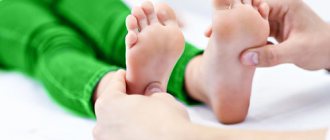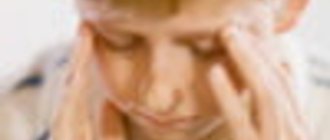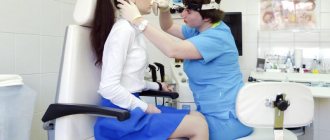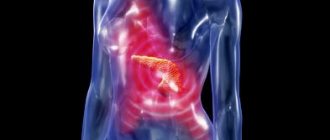One of the common reasons for visiting a medical facility or calling emergency services at home is pain above the navel. This symptom does not allow a quick diagnosis and requires additional assessment of body functions. It may be associated with the development of pathologies of several internal organs or indicate temporary and non-hazardous processes for health, and therefore life.
Zone location
The middle zone in the upper part (floor) of the abdomen is called the epigastrium (epigastrium). It starts from the sternum and extends down to the conventional line above the navel, connecting the lower ribs. On the left and right it is limited by the costal arches. The outer edge of the rectus muscles divides the upper part into the central zone and hypochondrium.
Topographic anatomy suggests that the epigastric zone includes:
- about a third of the stomach;
- bulb and upper part of the duodenum;
- the place of transition of the duodenum into the jejunum;
- left lobe of the liver;
- partially gallbladder and ducts;
- apex of buds;
- head and body of the pancreas;
- abdominal aorta with celiac trunk;
- a small section of the heart sac (pericardium);
- celiac plexus of nerve fibers and nodes;
- inferior vena cava.
From above, the epigastrium and the entire abdominal cavity are separated from the thoracic cavity by powerful muscles of the diaphragm. Through it, through a special opening, the esophagus approaches the stomach. The intestinal loops fit closely below.
According to the projection, the right hypochondrium zone includes: the liver with part of the gallbladder, the flexure of the colon, the right kidney with the adrenal gland. The left hypochondrium includes: the fundus, the cardiac part of the stomach and part of the body, the spleen, partially the left lobe of the liver, the caudal end of the pancreas, the left kidney.
Abdominal pain above the navel covers the central and lateral areas of the upper floor. We will look at the characteristics of acute and chronic organ damage that causes this symptom.
Pain due to pathology of the stomach and duodenum
Sudden paroxysmal pain in the upper abdomen in the middle appears with acute gastritis, food poisoning, or perforated ulcer. The intensity of gastric pain is weaker than with an ulcer. They follow the intake of food, alcohol, toxic substances and products.
Caused by contraction of muscle fibers, spasm. Accompanied by belching, heartburn, and vomiting of sour contents. They can radiate to the navel area, to the hypochondrium.
Sharp “dagger” pain during a peptic ulcer indicates a perforation of the wall and exit into the abdominal cavity
During penetration, patients are often in a state of painful shock: they turn pale, covered in sticky cold sweat, blood pressure decreases, and a rapid, weak pulse is detected. A forced position with hands pressed to the stomach is typical. Due to the development of peritonitis, when pressing on the abdomen, the muscles feel stiff and tense.
Perforation often occurs during an exacerbation of peptic ulcer disease. But there are “silent” ulcers that previously went unnoticed by the patient and are detected only with a severe complication. In men, ulcer perforation is recorded 8 times more often than in women. Young and middle-aged people are affected.
In the chronic course of gastritis and peptic ulcers, exacerbations occur in the spring and autumn, when diet is violated, or in stressful situations. The pain in the middle of the upper abdomen feels constant, aching, dull.
In case of inflammation in the stomach, they appear half an hour to an hour after eating, and in case of duodenitis, duodenal ulcer - no earlier than 1.5 hours or at night, in the morning on an empty stomach. Eating “calms” the stomach with increased acidity. Patients relieve night pain by drinking warm milk.
In a hypoacid state, the pain is less severe, but more persistent. Intestinal function is impaired. Worrying about frequent diarrhea, bloating, heaviness. Patients are prone to infection and development of gastroenteritis.
Peptic ulcer disease causes impaired motility of the stomach and intestines, so patients are more likely to experience constipation. A long-term course of a stomach ulcer is accompanied by loss of appetite, nausea, weight loss, the development of iron deficiency anemia, and hypovitaminosis.
Other causes of pain above the navel
In addition to gastrointestinal diseases, pain above the navel can be caused by disturbances in the functioning of other organs - the gallbladder, reproductive organs in women, and in some cases, unpleasant sensations in cardiovascular diseases radiate to this part of the peritoneum.
- Inflammation of the gallbladder, cholelithiasis
. With this disease, unpleasant sensations of a paroxysmal nature arise above the navel and radiate to the right hypochondrium; in addition, patients experience defecation disorders, appetite disturbances, frequent belching and a bitter taste in the mouth. - Umbilical hernia, purulent-septic processes
. The pain syndrome in this case depends on the severity of the pathological process, intensifies with palpation and, as a rule, is accompanied by tissue changes - a small swelling appears in the navel area, sometimes with purulent contents inside. - Gynecological diseases
. Diseases that may cause pain in the navel area include endometriosis and other inflammatory processes of the reproductive organs, as well as neoplasms of the uterus or ovaries and ectopic pregnancy. This symptom is not indicative or specific for such disorders, but occurs in approximately 10% of cases. Along with discomfort, women experience menstrual irregularities, sometimes bloody or purulent vaginal discharge. - Spleen lesions
. An enlarged spleen, which occurs in autoimmune diseases, tuberculosis, and disorders of the hematopoietic process, is manifested by pain in the navel, weakness, shortness of breath, and pale skin. - Osteochondrosis
. Degenerative changes in the spine are sometimes characterized by symptoms that resemble gastritis, and they intensify with physical activity and decrease with rest. - Cardiovascular pathologies
. With angina pectoris and myocardial infarction, pain can occur in the most unexpected places and often resemble pain due to gastrointestinal lesions. Cardiovascular pathologies can be distinguished from digestive pathologies by the following characteristics: they are not associated with the process of eating and are not accompanied by nausea, diarrhea or constipation, but by surges in blood pressure, shortness of breath and arrhythmia.
How does the liver and gallbladder hurt?
Hepatitis - inflammation of the liver parenchyma - does not cause severe pain; patients complain of a feeling of heaviness, fullness in the epigastrium and right hypochondrium. The disease causes loss of all organ functions.
Therefore, severe intoxication manifests itself: high fever, nausea, dizziness. Diarrhea is a consequence of impaired synthesis of digestive enzymes. Failure of hormonal balance during a long course of hepatitis leads to infertility in adult men and women.
Liver damage, in addition to pain, is characterized by the following symptoms. Yellowness of the skin, sclera, and mucous membranes is caused by impaired outflow of bile and destruction of hepatocytes. The feces become light-colored and the urine darkens due to altered metabolism of the bilirubin pigment.
Manifestations of portal hypertension - increased pressure in the vessels of the portal vein (with cirrhosis):
- dilation of the veins of the esophagus, the anterior wall of the abdomen (“head of the jellyfish”);
- ascites in the abdominal cavity (fluid accumulation);
- enlargement of the spleen due to the deposition of part of the blood.
Hepatic encephalopathy - fatigue, apathy, drowsiness and impaired consciousness up to coma, are associated with the cessation of detoxification and the effect of toxic waste on the brain. Hepatic colic refers to attacks of pain caused by spasm or obstruction of the gallbladder and ducts. They are caused by the advancement of stones or disruption of the nervous regulation of smooth muscles (dyskinesia).
Gallstone disease is manifested by cramping pain under the ribs on the right with irradiation into the epigastrium, into the chest to the level of the collarbone, into the shoulder, and scapula. At the same time, nausea and bitter vomiting appear, which does not bring relief to the patient. An attack can last several hours and be accompanied by fever, chills, weakness, and headache.
A mechanical obstruction in the bile ducts can be judged by yellowness of the skin and sclera, and itching.
Disturbed central regulation causes too much spastic contraction of the bile ducts or relaxation
Dyskinesia of the hyper- or hypokinetic type is characteristic of people who are nervous, emotional, and prone to worry. The patient feels either cramping, short-term pain, or dull pain caused by stretching and overflow of bile. The symptom is regarded as a harbinger of cholecystitis.
Acute cholecystitis is an inflammation of the gallbladder wall, often combined with the presence of stones, then called calculous. The onset is usually sudden, at night. Obese women are most susceptible to the disease. In the chronic course, attacks are provoked by poor diet (fatty and fried foods), physical activity, stress, and shaking in transport.
Each exacerbation causes attacks of pain in the upper abdomen on the right. During the interictal period, patients feel dull pain in the abdomen, back, nausea, suffer from heartburn, unstable stools, flatulence, and itchy skin. Headaches, insomnia, weakness, and memory loss occur.
Particular attention is paid to the possibility of liver injury. Doctors urgently need to find out why the stomach hurts during accidents, a fall, or an accident. The organ is damaged by a fracture of the ribs, and the capsule ruptures from a mechanical shock.
The pain is localized in the victim's upper abdomen and radiates to the right collarbone and scapula. The intensity depends on the severity of the damage. A typical symptom of “Vanka-Vstanka” is increased pain in a horizontal position and weakens in a sitting position, so the victim always refuses to lie down.
Liver injury is dangerous due to the development of massive internal bleeding. It cannot stop spontaneously; the blood is mixed with bile and loses its ability to clot. The person becomes pale, blood pressure decreases, and sticky sweat appears on the skin. The condition is life-threatening. Emergency measures are needed.
Treatment tactics
The treatment regimen is drawn up by the attending physician after a comprehensive examination based on the information received. Treatment tactics depend on the diagnosis and the disease causing the stomach to become hard. Complex methods are used, taking into account the patient’s condition and the area of development of pathological processes.
A hard abdomen (a comprehensive diagnosis will help determine the causes in women) is treated with medications, which the doctor selects for each patient individually, taking into account numerous factors. It is important to strictly adhere to prescriptions and dosages to reduce the likelihood of side effects.
| Group of drugs | Name | Application |
| Adsorbents | Polysorb, Smecta | Medicines reduce gas formation. The product is diluted in water (0.5 tbsp) and taken orally 1 hour before meals. The average daily dosage for an adult patient is 0.1-0.2 g, which should be divided into 3-4 doses. The course of treatment depends on the severity of the disease and is carried out over 3-14 days. |
| Enzymes | Mezim, Pancreatin | The drugs promote the digestion process. Medicines are taken orally, 1-3 tablets before meals, with a sufficient amount of water. |
| Hepatoprotectors | Karsil, Allohol | Medicines replace bile and increase its production. Adult patients are prescribed 1 capsule 3 times a day. The course of therapy lasts 3 months. |
| Antispasmodics | Papaverine, Dicetel | Medicines eliminate excessive tension in the muscles of the anterior abdominal wall. The drug is administered intravenously, intramuscularly or subcutaneously. The standard dosage for an adult patient is 0.5-2 ml (10-40 mg). |
| Probiotics | Maxibalance, Biolact | The drugs restore the beneficial intestinal microflora, which is often disrupted by dysbacteriosis. It is recommended to take the medicine 1 capsule 2-3 times a day with a sufficient amount of warm water (250 ml). The duration of therapy is 14 days. |
Complex treatment for the appearance of a hard belly also involves following a certain diet. It is necessary to completely exclude from the diet foods that increase flatulence and are difficult to digest.
A nutritionist will help you create a tentative menu.
| Recommended Products | Prohibited Products |
|
|
Additionally, following a diet and taking medications for a hard stomach, it is recommended to engage in physical activity, take walks every day, and do gymnastics. Tumors require radiation or chemotherapy. Severe or emergency cases are treated with surgery.
Pain due to pancreatic pathology
Diseases of the pancreas cause pain in the abdomen above the navel. They can radiate to the right and left hypochondrium, to the back, shoulder blades, spine, and to the umbilical zone. Often described by patients as "girdling".
In acute inflammation (pancreatitis) they appear suddenly. Preceded by alcohol consumption, fatty and fried foods, excessive overeating. The pain is very intense, accompanied by nausea and repeated vomiting without relief.
Why does my stomach and back hurt at the same time?
Severe intoxication is caused by enzymes entering the blood. Upon examination, cyanosis of the face and limbs, pinpoint hemorrhages on the abdomen, buttocks, and severe pain in the abdomen are revealed.
Chronic pancreatitis manifests itself depending on the degree of organ damage:
- inflammation in the head of the gland and body - gives a picture of right-sided pain radiating to the abdominal cavity, chest, shoulder blade and back;
- when localized only in the tail and body, pain spreads from the left hypochondrium and epigastrium to the left side, scapula;
- Total inflammation is characterized by girdle pain.
An exacerbation causes “cutting, drilling” pain, which intensifies while lying down in the evening. Hunger helps relieve pain. Other signs worth noting:
- diarrhea several times a day with remnants of undigested particles and a fatty film in the stool (patients notice that they are difficult to flush down the toilet);
- increased production of saliva;
- burping;
- nausea and vomiting;
- bloating;
- loss of appetite with aversion to fatty foods;
- weight loss
Pancreatitis may be accompanied by signs of dysfunction of the gallbladder, stomach, and intestines
A malignant tumor of the pancreas is most often localized in the head. The growth of the formation serves as a mechanical obstacle to the outflow of bile and enzymes of the gland itself. Therefore, clinical symptoms are detected early by attacks of hepatic colic, prolonged jaundice with a bronze tint.
The location of cancer in the body or area of the tail of the gland makes it possible to get sick much later. Sometimes, before the development of severe pain, the patient notes a decrease in appetite, a feeling of heaviness in the epigastrium and just above the navel, nausea, belching, and bloating.
A large tumor of the pancreas can grow into the solar plexus and is then accompanied by very intense pain in the back and spine, which intensifies at night.
Causes and types of abdominal pain in children
A child's stomach can hurt for several reasons. Depending on the source of pain, there are:
- 1
Organic pain – associated with functional and other disorders in the functioning of the gastrointestinal tract. - 2
Inorganic pain is not related to the functioning of the gastrointestinal tract, caused by disorders in other organs and systems.
- 3
Psychosomatic pain – arising from stress, appearing in the absence of any disturbances in the functioning of internal organs.
Pain due to lesions of the spleen
Pain is caused by stretching of the spleen capsule. It is characterized by massive innervation and responds to swelling and enlargement of the organ. Abscess and infarction of the spleen can also cause pain. The intensity is more similar to the feeling of heaviness in the left hypochondrium and epigastrium.
Enlargement of the spleen occurs:
- for acute and chronic infectious diseases (tuberculosis, infectious mononucleosis, malaria, septic condition);
- massive hemolysis of red blood cells (hemolytic anemia, long-term hemodialysis);
- blood deposition and congestive enlargement due to portal hypertension;
- autoimmune diseases (systemic lupus erythematosus);
- blood diseases (lymphomas, lymphocytic leukemia, myeloid leukemia).
In addition to pain, hypersplenism syndrome is manifested by: a decrease in all blood cells (pancytopenia), severe anemia (pallor, shortness of breath, weakness, dizziness), a tendency to infections and bleeding.
The spleen deposits some of the blood to relieve the hepatic network
Pain caused by hernia of the white line of the abdomen
The linea alba is the interweaving of the tendon bundles of the broad abdominal muscles. It stretches from the sternum vertically to the pubic joint. Weak spots are the openings where blood vessels and nerves pass.
Pain in the upper center of the abdomen masks any of the listed diseases. A significant difference in diagnosis is the lack of connection with the time of intake and the nature of food, increased after stress on the abdominal muscles, coughing, straining, laughter.
First, fatty tissue penetrates into the defect. Along with it, nerve endings from the solar plexus can enter the hernial orifice. This is how the cause of pain is formed. Further development is accompanied by bulging of the peritoneal layer and the formation of a hernial sac.
Epigastric hernias do not reach large sizes. They are detected when there is strangulation, when, after a decrease in intra-abdominal pressure, part of the hernial sac does not have time to move into the inlet. The wall of the stomach, intestines, omentum, and gall bladder can become trapped. A local painful formation is palpated. It is necessary to eliminate the infringement before the formation of necrosis.
Pain in the stomach during myocardial infarction
Myocardial infarction is a disease of the heart muscle deprived of blood and oxygen. An area is formed in the myocardium with zones of necrosis and ischemia. One of the variants of the atypical course is the gastralgic form. It is most typical for damage to the posterior wall of the left ventricle.
It is impossible to distinguish the pain from epigastric diseases by the nature of the pain. Additional symptoms help in diagnosis:
- the patient experiences shortness of breath at rest or with little physical exertion;
- palpitations, arrhythmia;
- blood pressure response;
- lack of connection between pain and food intake.
The final answer is given by an ECG examination of the patient.
Gut is thin
Intestinal intussusception also occurs in young children, which also gives a picture of an acute abdomen. What happens? The intestine of the lower section is “implemented” into the overlying one. Due to the resulting narrowing, the intestinal vessels are pinched and blood circulation is disrupted.
The main danger is that necrosis (death of tissue) of the intestine may develop. In infants, intussusception most often occurs due to improper introduction of complementary foods with vegetables or fruits, which increase peristalsis. Moreover, this happens much more often in boys than in girls. In older children, the cause may be an abnormal protrusion of the wall of the small intestine, polyps on the inner wall of the intestine, a tumor and other pathologies that impair motility. Very often the disease develops suddenly:
● The child cries, breaks out in sweat, bends over, twists his legs.
● After the first attack, which lasts 5–10 minutes, the child becomes lethargic and apathetic until the next attack. As the attacks become more frequent, bloating develops.
● Blood is visible in the stool.
● Vomiting may occur, after which peristalsis can be heard; vomit contains blood mixed with mucus, resembling raspberry jelly.
● Sometimes between attacks you can feel a lump in the intestines - a “bump” in the tummy.
● Your temperature may rise.
If such symptoms appear, the child must be hospitalized immediately. If no more than 12–18 hours pass from the first attack of pain to the start of treatment, the strangulated area of the intestine can be saved.
To establish a diagnosis of intussusception, the child is given an x-ray: an enema with a barium sulfate solution is given so that the damaged area becomes “visible” during examination.
If time is not lost, air is pumped into the colon through the rectum, and under the influence of pressure it gradually straightens.
When the child is brought to the hospital too late, surgery is necessary. It can be performed using laparoscopy: the surgeon manually, applying slight pressure, straightens the damaged area. In cases where necrosis of the intestinal tissue does occur, the surgeon cuts out the damaged area and then stitches the healthy edges of the intestine.
Pain due to abdominal aortic aneurysm
If a person over 50 years of age complains of epigastric pain, it can be assumed that he has significant atherosclerotic damage in the form of deposition of cholesterol plaques into the wall of the abdominal aorta.
Another cause of aneurysm is chronic syphilis
The loss of elasticity of a section of a large vessel passing in the epigastric zone contributes to the gradual formation of an expansion with thinned walls. The tissue around the aneurysm becomes inflamed. When large in size, it can compress the stomach, inferior vena cava, intestines, and liver.
Pressure on the spine may cause sensory disturbances and paralysis in the legs. The pain lasts for several hours. Appear in the late afternoon or at night. An aneurysm is revealed by palpation of the abdomen in the form of a large pulsating tumor.
First aid for hard belly symptoms
In case of overeating or poisoning, you can cope with a hard stomach on your own. In this situation, the first aid will be sorbents or enzymes that support the process of food digestion.
If concomitant serious symptoms appear, you must immediately call an ambulance and provide the person with the following actions before the doctor arrives:
- Provide the patient with complete rest.
- Put the patient to bed, unfasten tight clothes.
- Do not give water, food, or medications to a person until a doctor arrives, as this may make the health condition worse or hide serious symptoms. A specialist may make an incorrect diagnosis.
- A cold compress can be applied to the area where there is severe pain.
Further assistance is provided by the doctor, taking into account the person’s condition. The specialist decides whether the patient can be treated at home or whether he requires urgent hospitalization.
Pain caused by spinal osteochondrosis
Osteochondrosis is formed by degenerative changes in the discs between the vertebrae. In this case, a person experiences chronic pain in the upper abdomen, reminiscent of gastritis. They intensify not from eating, but when turning the body, physical work, and noticeably subside after rest. The doctor identifies the most painful points by palpating the paravertebral area.
Deformation in the lower thoracic region contributes to compression of the nerve roots emanating from the spinal canal
Pain in the abdomen and spine in advanced pregnant women requires special attention. If a woman’s spine is not accustomed to physical activity, then the weight of the fetus is perceived with difficulty. The pain is caused by sprained ligaments of the intervertebral joints. They go away after childbirth.
Modern types of examination make it possible to identify the cause and clarify the nature of damage to the organs of the upper abdomen. Patients are not recommended to endure and try to treat themselves. This can cause complications and complicate further treatment.
When is specialist advice needed?
A hard abdomen (the causes in women will be determined by a diagnosis that a specialist will prescribe, taking into account the patient’s complaints) requires consultation with a gastroenterologist when the first signs of a disease or disorder in the body appear. It is important not to ignore a pathological condition that has been present for a long time.
Emergency medical care is necessary for a person in the presence of intense pain syndrome, if the process of bowel movement is disrupted. The same applies to a sharp deterioration in health with loss of consciousness and a decrease in blood pressure. Timely therapy will help you quickly take control of the disorder and prevent possible consequences.
A hard belly should not be ignored, especially if discomfort and unpleasant sensations have been bothering you for a long time. A comprehensive diagnosis and consultation with a doctor will allow you to establish the main cause of a woman’s pathological condition. You cannot treat yourself, since incorrectly selected therapy can lead to negative complications.









